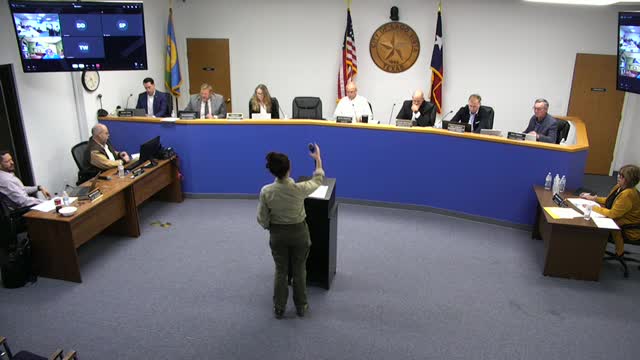Council hears Texas A&M expert on oak wilt; ordinance debated and tabled for revision
January 16, 2025 | Lago Vista, Travis County, Texas
This article was created by AI summarizing key points discussed. AI makes mistakes, so for full details and context, please refer to the video of the full meeting. Please report any errors so we can fix them. Report an error »

A Texas A&M woodland ecologist explained oak wilt transmission and management to Lago Vista City Council on Jan. 16, 2025, as the council considered a proposed amendment to the city code to strengthen disease-prevention rules.
Camille Wiseman, identified in the presentation as a woodland ecologist and ISA-certified arborist, described how oak wilt spreads both by root grafts among live oaks and by sap-feeding beetles that visit fungal mats on dead red oaks. "Oak wilt is a disease caused by a fungus, Brezillia fagacereum," she said, and she emphasized that red oaks often form the fungal mats that attract beetles. Wiseman recommended avoiding pruning or creating open wounds on oaks during the spring beetle-activity window (she gave a recommended no-pruning period of Feb. 1 through June 30), sealing significant wounds immediately, and prioritizing removal and destruction (chipping or burning) of infected red oak wood to prevent new centers.
Wiseman explained mitigation options for established centers: trenching (a containment trench 4'5 feet deep placed outside the infected root zone) or targeted propiconazole injections for high-value trees where trenching is impractical. She noted trenching can be costly and logistically difficult near infrastructure, and she gave an approximate contractor cost of about $5 per foot for a trench (her example suggested small trench projects could reach about $10,000).
Councilmembers asked about penalties, liens and enforcement: some members urged caution before imposing criminal penalties or liens on private property. One councilor asked that the ordinance remove lien language and that penalties be civil rather than criminal; another councilor said stronger penalties were needed to deter contractors who repeatedly prune during the high-risk window. The proposed ordinance revisions posted on the city's discussion board after staff review respond to several points raised in the council's discussion, including limiting mandatory removal language to red oaks (which pose the highest risk of creating new fungal-mat centers) and clarifying exceptions for public-safety pruning after storms.
After extended discussion, the council voted to table the ordinance to the next council meeting to allow staff to consolidate the edits posted to the discussion board, produce a single redline version for review, and include an education and outreach plan. Councilmember Benfield moved to table; Councilmember Prince seconded; the motion passed unanimously.
Ending: Staff was directed to return a consolidated redline ordinance with the requested clarifications (focus on red oaks, civil penalties vs. misdemeanor options, lien language options) and to run an education campaign with a video or web page summarizing the expert guidance (pruning window, wound sealing, handling of red-oak wood).
Camille Wiseman, identified in the presentation as a woodland ecologist and ISA-certified arborist, described how oak wilt spreads both by root grafts among live oaks and by sap-feeding beetles that visit fungal mats on dead red oaks. "Oak wilt is a disease caused by a fungus, Brezillia fagacereum," she said, and she emphasized that red oaks often form the fungal mats that attract beetles. Wiseman recommended avoiding pruning or creating open wounds on oaks during the spring beetle-activity window (she gave a recommended no-pruning period of Feb. 1 through June 30), sealing significant wounds immediately, and prioritizing removal and destruction (chipping or burning) of infected red oak wood to prevent new centers.
Wiseman explained mitigation options for established centers: trenching (a containment trench 4'5 feet deep placed outside the infected root zone) or targeted propiconazole injections for high-value trees where trenching is impractical. She noted trenching can be costly and logistically difficult near infrastructure, and she gave an approximate contractor cost of about $5 per foot for a trench (her example suggested small trench projects could reach about $10,000).
Councilmembers asked about penalties, liens and enforcement: some members urged caution before imposing criminal penalties or liens on private property. One councilor asked that the ordinance remove lien language and that penalties be civil rather than criminal; another councilor said stronger penalties were needed to deter contractors who repeatedly prune during the high-risk window. The proposed ordinance revisions posted on the city's discussion board after staff review respond to several points raised in the council's discussion, including limiting mandatory removal language to red oaks (which pose the highest risk of creating new fungal-mat centers) and clarifying exceptions for public-safety pruning after storms.
After extended discussion, the council voted to table the ordinance to the next council meeting to allow staff to consolidate the edits posted to the discussion board, produce a single redline version for review, and include an education and outreach plan. Councilmember Benfield moved to table; Councilmember Prince seconded; the motion passed unanimously.
Ending: Staff was directed to return a consolidated redline ordinance with the requested clarifications (focus on red oaks, civil penalties vs. misdemeanor options, lien language options) and to run an education campaign with a video or web page summarizing the expert guidance (pruning window, wound sealing, handling of red-oak wood).
View full meeting
This article is based on a recent meeting—watch the full video and explore the complete transcript for deeper insights into the discussion.
View full meeting
